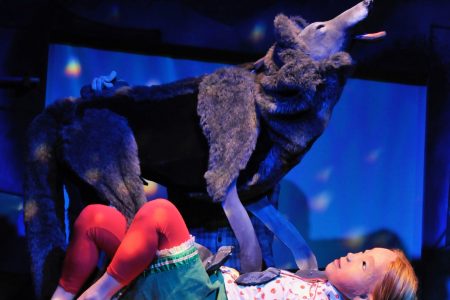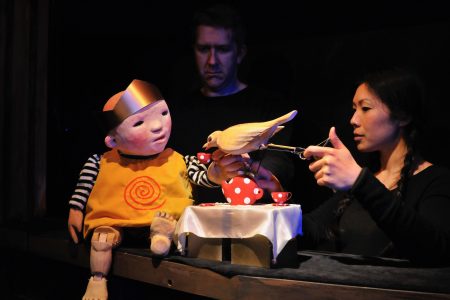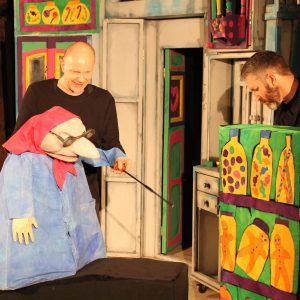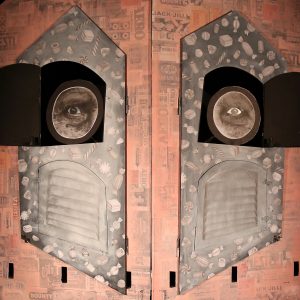2011: Red Riding Hood
We wanted to follow Storm in a Teacup with another children’s show. Alison Duddle was particularly keen on creating a series of shows based on traditional stories, and she decided on Red Riding Hood. One argument for doing this was that audiences were more likely to go to a show that they had heard of, than something new and unknown. Alison then wrote a treatment of Red Riding Hood that was atmospheric, quirky and constantly surprising. We decided that she should direct the production and make most of the puppets. I provided support as necessary, including designing and making the set, and worked with Vanessa Card on several short filmed animations that were interspersed throughout the story.
This turned out to be a very popular production and toured on and off for several years.
Horse and Bamboo’s first foray into the adaptation of a classic fairytale revels in a delicious combination of the scary and the playful. Drawing from the tale’s rich history and multiple readings, including the Norse myth of spring’s escape from winter’s jaws (in which the Little Red’s red hood represents the stolen sun), Alison Duddle’s treatment steps delicately amongst various interpretations to create a deceptively simple telling that nonetheless resonates with symbolism and menace.
The two performers, Jonny Quick and Frances Merriman, are the anchors that carry us through the production’s diverse storytelling approaches and techniques. Jonny is always hungry – the show almost doesn’t begin as he wants to nip out for a sausage roll, whilst Frances is excited to share her collection of all things red. Her most treasured possession: a tasty pink-iced bun become an edible symbol of the protagonist (that) she puppets, it’s delicious demise threatened, or promised, from the start. These two characters and their careful positioning in-between the dramatic and storytelling worlds offered an easy point of entry to the material and to the performance’s conventions.
The production moved easily between miniature theatre, mask work, rod puppetry, shadow, film, song and storytelling: it offered a wonderful introduction to some of the pleasures and surprises of visual theatre (of which for me the company’s mask work begins to feel the most staid). These shifts in mode allowed the story at times to touch on the real darkness of the fairytale’s threat. As an echoing sound effect that far out-scales the apparent safety of a miniature home where Red Riding Hood is tucked up in bed, or an unseen animated shadow trailing her through the woods and able to completely disappear behind trees, the wolf exudes genuine menace which sent children scurrying back to their seats (Loz Kaye’s score really contributed to the creeping sense of horror). As Jonny Quick with a wiggly extended furry nose gleefully stuffing a cake into his mouth the menace was contained, though perhaps more performatively subversive in its implications.
All in all, this was a thoughtful, exciting and playful production. Playing to sell-out audiences in the company’s own venue, The Boo, which hasn’t long been able to offer public performances, Little Red Riding is a wonderful offer to local Lancashire audiences. Horse and Bamboo are to be congratulated for demonstrating just what a rich and welcoming experience visual theatre can offer to new audiences.
These shows were created and directed by Alison Duddle, and I didn’t play much of a part in them. I wanted to include them here in part to complete the list of Horse + Bamboo productions, but also to say a little about Alison’s role within the company. After the success of Red Riding Hood, Alison wanted to continue with adaptations of traditional tales. She was also very keen to pursue the idea of adapting a Moomintroll story for the stage, as we were both big fans of Tove Jansson’s work. Alison was continually looking out for possible partners to help achieve this goal.
2011: The Nightingale
In the period following Red Riding Hood, Alison adapted Hans Christian Andersen’s ‘The King and the Nightingale’, although initially we called it The Twittering Machine. I worked on the set for this show but otherwise had almost no input. I felt that it could be a worthy successor to Red Riding Hood. Alison, however, was dissatisfied with it and so it underwent several major rewrites and redesigns. Something similar happened with Hansel & Gretel, her next and third show in the folk tale trilogy. Alison worked hard with a team including Jonny Quick, Mark Whitaker, and Aya Nakamura as performers. Loz Kaye worked as the Musical Director. Jonny designed and made the sets too – but once again it went through several rewrites and redesigns.
A major change
Arts Council policies at this time were being radically rewritten and redesigned. Funding cuts were creating a more hostile environment for touring theatre companies. More drastically, it was made clear that future funding for Horse + Bamboo was only going to be available if it was spent on our building and community programming. It was not, we were told, to be used to write, create and produce further touring shows. The Arts Council were pretty intransigent about this, and the Horse + Bamboo Board chose not to argue with them. It was a chain of events that I had most feared when we moved to the Boo in 1998. It was the moment when we took on a venue in addition to being a theatre company.
The combination of recent shows that had needed constant re-working, and the drying up of Arts Council funding, left the Board feeling that they had to take some difficult decisions. The most significant and dramatic of these by far, taken suddenly at the end of 2016, was cutting Alison Duddle’s post as Joint Artistic Director. This event was an enormous shock for Alison. She was expecting to take over the Artistic Director role when and if I retired. It was also a traumatic event for most of the company, myself included. Overnight it changed the direction and feel of the group, and I decided that I should now wrap things up in as tidy a way as I could, and leave.
2014: Moomintroll Midwinter
Alison had managed to achieve one of her dreams during this period, which was to co-direct a medium-scale production of one of Tove Jansson’s Moomintroll stories, which we all loved. It wasn’t a straightforward process – an early attempt to work in partnership with Nottingham Playhouse faltered and then completely fell through, largely because the two directors had incompatible visions of how to do this, and couldn’t even agree as to which Moomintroll book would make the best stage adaptation.
Meanwhile we had been slowly building up a good relationship with the egg, a venue for young people in Bath and part of the Theatre Royal group. This was helped by already having taken a number of our successful touring shows there, so that both companies already knew something about one another. The egg, like us, were keen on the Moomintroll books, as well as pursuing possible co-productions, and so we began discussing the idea of a show that would be jointly directed and produced.
Nothing was easy. Horse + Bamboo had never really worked with an international franchise on the scale of the Tove Jansson Foundation. Working with Barefoot Books and Guo Yue on Little Leap Forward, or the Charlotte Salomon Foundation, had been plain sailing compared to this. Moominland Midwinter was selected as the starting point; Hattie Naylor was contracted to write the stage play, and Tom Rogers to do the stage design. Hattie’s script had to be agreed with the Tove Jansson representatives in every last detail, of course, but the look of the puppets also had to conform to copyright expectations, right down to the precise Pantone colours used in the costumes. Financial arrangements were inevitably complex too, as they had to be worked out between three parties. There were plenty of other practical problems too. To take one example, if we exactly replicated the way Moomintroll’s arms were drawn in the books, then the puppets wouldn’t be able to function properly on stage, certainly they would be unable to pick up objects. Compromises on issues like this had to be worked through; England to Finland and back again, over and over.
But Alison, with Kate Cross and Lee Lyford from the egg persisted and, very slowly, progress was made. Loz Kaye wrote the music and, of course, Alison made the puppets. After a long period of uncertainty and many discussions involving the Jansson organisation in Finland, by 2013 the permissions were finally in place. Work on the production then started.
The resulting show was delightful. It looked beautiful, and audiences enjoyed it, though I was grateful not to have been involved. Not having complete directorial control would have been too much for me. It was a good show, but I couldn’t but feel that it was just a little too safe; it lacked the singular vision that might have been possible if the directors had been allowed to cut loose more. But I also recognise that in this new world (for us) of copyrights, coproductions and franchises, it probably could never have happened. Nevertheless, Alison achieved one of her dreams; she put a Moomintroll show onto the stage, something that she had wanted to do for at least a decade.

Christmas is a great time for tradition. In Sweden, the midwinter festival has been a big deal for a very, very long time, but they do things differently there. This production of Moominland Midwinter at Sale Waterside, courtesy of Rossendale’s Horse + Bamboo and the egg theatre in Bath, is certainly a festive presentation, but it’s no panto. That’s not to say it isn’t fun. Quite the opposite. It’s a real delight which children will relish. But on the quiet it’s also got a depth to it which goes deeper than the usual tinsel trappings and gaudy excess. Fittingly, it’s very Scandinavian.
Anyone who has grown up exposed to Tove Jansson‘s Moomins, whether via the original books or the various screen adaptations, will know that there’s a gently melancholy streak to them which makes them hard to forget. Sure enough, this show opens with our fusspot hero Moomintroll waking up to a snow-bedecked world and wandering about in it feeling very lonely. Before too long, though, he starts to meet others, among them a ditsy squirrel, dour Little-My and philosophical sort Too Ticky. The result is a lively adventure of discovery and wonder, with lots of uproarious antics. But there are also lots of quiet, reflective moments about the circle of life, with nature portrayed as a force that can be harsh and scary as well as beautiful and magical. Yet it’s all done so deftly, and with such a lightness of touch, that children will have no trouble absorbing it.
The result as a whole is truly impressive, and it definitely stays faithful to the spirit of Jansson’s unique original vision. It’s a small-scale puppet production with visible puppeteers, but they’re dressed in suitably Scandi black outfits and woolly hats so their presence quickly becomes invisible once the story gets going. There’s plenty of ingenuity in the staging, with a very tight, skilful company creating an entire world between them. In particular, Mark Whitaker lights up proceedings with an array of daffy characters, not least the over-enthusiastic Hemulen and an unleashed troll. There are comic set-pieces a-plenty, and larks abound. Lots of fun is had with different perspectives of scale. There’s a very nicely judged use of evocative music throughout, too. The pacing meanders a little in the second half, and tiny theatregoers might begin to wriggle before the end. But it wraps up perfectly, and besides, it’s a world you’ll enjoy being immersed in. All told, it’s something pretty special. Festive tweeness is not the order of the day here. Instead it’s a genuinely rounded, irresistible visit to a glorious winter wonderland.













